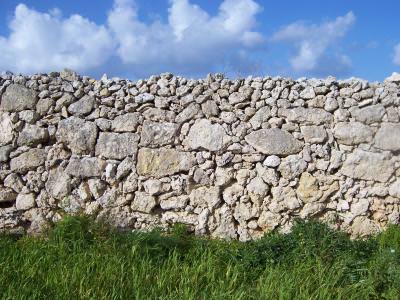Rubble masonry
Rubble masonry, also known as rubblework, is the use of undressed, rough stone, generally for the construction of walls.
The most basic form of rubble masonry is dry-stone rubble walls which are very common in rural locations and popular with landscapers looking for a traditional aesthetic. The rough, unhewn stones are piled on top of one another without mortar, and are often laid in irregular horizontal courses.
Alternatively, the stones can be bound with cement or lime mortar, although in this case, a greater degree of stone selection may be required to avoid excessively wide mortar joints. Stones can be bonded by laying longer ones both along the face and oriented lengthwise across the depth of the wall. Selected stones are laid to form roughly square angles at quoins and around openings.
Polygonal rubble walling is where stones are split-faced and roughly dressed to suit a specific pattern or design. Random rubble walls involve stones of varying sizes and joint widths with small wedge-shaped fillets bedded into the mortar between them.
Rubble masonry can also be used as the outer surface of a wall, particularly common in medieval cathedrals and historic buildings, and as a core infill between external and internal wall faces.
[edit] Related articles on Designing Buildings Wiki
Featured articles and news
Moisture, fire safety and emerging trends in living walls
How wet is your wall?
Current policy explained and newly published consultation by the UK and Welsh Governments.
British architecture 1919–39. Book review.
Conservation of listed prefabs in Moseley.
Energy industry calls for urgent reform.
Heritage staff wellbeing at work survey.
A five minute introduction.
50th Golden anniversary ECA Edmundson apprentice award
Showcasing the very best electrotechnical and engineering services for half a century.
Welsh government consults on HRBs and reg changes
Seeking feedback on a new regulatory regime and a broad range of issues.
CIOB Client Guide (2nd edition) March 2025
Free download covering statutory dutyholder roles under the Building Safety Act and much more.
AI and automation in 3D modelling and spatial design
Can almost half of design development tasks be automated?
Minister quizzed, as responsibility transfers to MHCLG and BSR publishes new building control guidance.
UK environmental regulations reform 2025
Amid wider new approaches to ensure regulators and regulation support growth.
The maintenance challenge of tenements.
BSRIA Statutory Compliance Inspection Checklist
BG80/2025 now significantly updated to include requirements related to important changes in legislation.
Shortlist for the 2025 Roofscape Design Awards
Talent and innovation showcase announcement from the trussed rafter industry.























